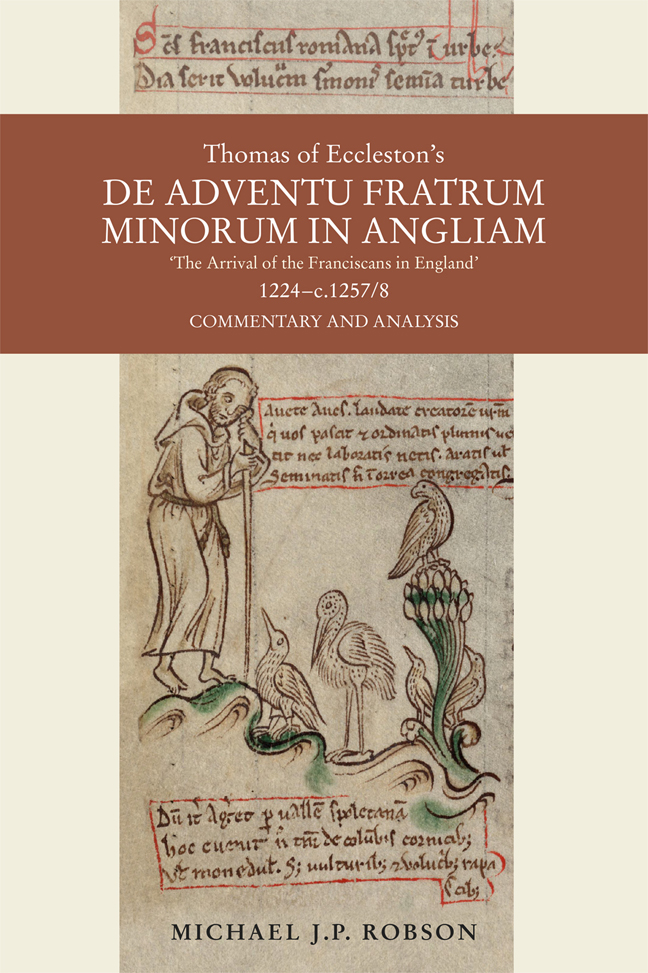Book contents
- Frontmatter
- Dedication
- Contents
- Acknowledgements
- List of Abbreviations
- Timeline
- Introduction
- 1 The launching of the mission to England
- 2 The first foundations
- 3 The admission of novices
- 4 The growth of the Franciscan community
- 5 The fervour of the early friars
- 6 The office of preaching
- 7 The seven custodies
- 8 The three general visitators
- 9 The Irish and Scottish provinces
- 10 The relocation of friaries and their enlargement
- 11 The friars’ schools of theology
- 12 The confessors
- 13 The ministers general
- 14 The ministers provincial
- 15 A gallery of friars
- A post script
- Bibliography
- Index
- Miscellaneous Endmatter
14 - The ministers provincial
Published online by Cambridge University Press: 02 March 2024
- Frontmatter
- Dedication
- Contents
- Acknowledgements
- List of Abbreviations
- Timeline
- Introduction
- 1 The launching of the mission to England
- 2 The first foundations
- 3 The admission of novices
- 4 The growth of the Franciscan community
- 5 The fervour of the early friars
- 6 The office of preaching
- 7 The seven custodies
- 8 The three general visitators
- 9 The Irish and Scottish provinces
- 10 The relocation of friaries and their enlargement
- 11 The friars’ schools of theology
- 12 The confessors
- 13 The ministers general
- 14 The ministers provincial
- 15 A gallery of friars
- A post script
- Bibliography
- Index
- Miscellaneous Endmatter
Summary
A brief sketch of the first three ministers provincial of England – Agnellus of Pisa, Albert of Pisa and Haymo of Faversham – is given by Eccleston, who presents each one as an exemplary friar. These friars had already featured in several of the earlier collationes, especially Haymo, who held several major offices prior to his election as minister provincial in the summer of 1239. The ministers provincial supervised the life and ministry of the friars and witnessed the order’s agreements with neighbouring institutions and individuals, notably the chirograph with Reading Abbey on 14 July 1233. The length of this ministry differed from one province to another. Haymo held office for a year before being elected as minister general, while William of Nottingham served for fourteen years until he was removed from office in 1254 by the general chapter of Metz. The minister provincial upheld standards and led the province. He collaborated with the regional custos and appointed friars to the offices of confessor, lector, preacher and penitentiary and assigned them to lecture in the schools. The minister provincial visitated the friaries on an annual basis and corrected friars who had been undisciplined or caused scandal. He liaised with local bishops in all that pertained to the public life of the friars and their church. They were required to pay close attention to relations with the crown, one of its major benefactors. It was not unusual for the minister provincial to be invited to court, perhaps to preach. A special responsibility of the minister provincial was the care of the sick friars. A good insight into the office of minister provincial is provided by the copious correspondence of Adam Marsh with William of Nottingham. The minister provincial contributed to the life of the order on the international stage and attended the triennial general chapters. He responded to pleas from the minister general for some friars to be appointed to friaries outside England. Adam of Exeter was given permission to proceed to the Holy Land, but died en route at Barletta in 1233/34. Arnulph was one of a number of English friars attached to the papal court as chaplains and penitentiaries by 1239. Ministers provincial were required to attend the triennial general chapters and to elect the ministers general. Haymo of Faversham was depicted as playing a major role in the general chapter of Rome in 1239, when Albert succeeded the deposed Elias.
- Type
- Chapter
- Information
- Thomas of Eccleston's De adventu Fratrum Minorum in Angliam 'The Arrival of the Franciscans in England', 1224-c. 1257/8Commentary and Analysis, pp. 259 - 271Publisher: Boydell & BrewerPrint publication year: 2023

